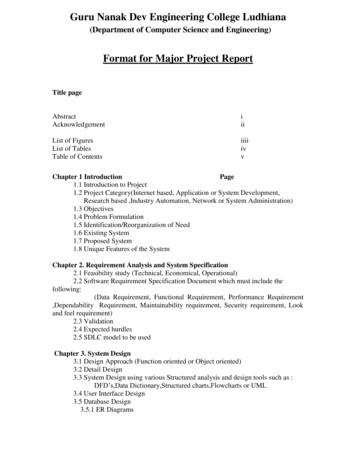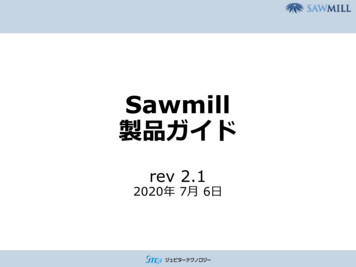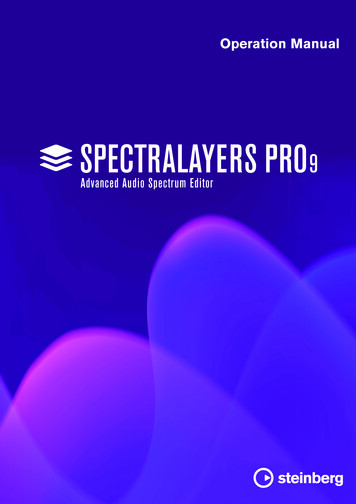
Transcription
Guru Nanak Dev Engineering College Ludhiana(Department of Computer Science and Engineering)Format for Major Project ReportTitle pageAbstractAcknowledgementiiiList of FiguresList of TablesTable of ContentsiiiiivvChapter 1 IntroductionPage1.1 Introduction to Project1.2 Project Category(Internet based, Application or System Development,Research based ,Industry Automation, Network or System Administration)1.3 Objectives1.4 Problem Formulation1.5 Identification/Reorganization of Need1.6 Existing System1.7 Proposed System1.8 Unique Features of the SystemChapter 2. Requirement Analysis and System Specification2.1 Feasibility study (Technical, Economical, Operational)2.2 Software Requirement Specification Document which must include thefollowing:(Data Requirement, Functional Requirement, Performance Requirement,Dependability Requirement, Maintainability requirement, Security requirement, Lookand feel requirement)2.3 Validation2.4 Expected hurdles2.5 SDLC model to be usedChapter 3. System Design3.1 Design Approach (Function oriented or Object oriented)3.2 Detail Design3.3 System Design using various Structured analysis and design tools such as :DFD’s,Data Dictionary,Structured charts,Flowcharts or UML3.4 User Interface Design3.5 Database Design3.5.1 ER Diagrams
3.5.2 Normalization3.5.3 Database Manipulation3.5.4 Database Connection Controls and Strings3.6 MethodologyChapter 4. Implementation, Testing, and Maintenance4.1 Introduction to Languages, IDE’s, Tools and Technologies used forImplementation4.2 Coding standards of Language used4.3 Project Scheduling using various tools such as PERT, GANTT charts, OpenPROJ etc.4.4Testing Techniques and Test PlansChapter 5. Results and Discussions5.1 User Interface Representation (of Respective Project)5.1.1 Brief Description of Various Modules of the system5.2 Snapshots of system with brief detail of each5.3 Back Ends Representation (Database to be used )5.3.1 Snapshots of Database Tables with brief descriptionChapter 6. Conclusion and Future ScopeReferences/Bibliography
SPECIFICATIONS FOR MAJOR PROJECT REPORT1. Report shall be computer typed (English- British, Font -Times Roman, Size-12point) and printed on A4 size paper.2. The Report shall be hard bound with cover page in white colour. The name of thecandidate, degree (specifying the branch) ,roll no, session , year of submission,name of the University including college name shall be printed in black on thecover [Refer sample sheet (outer cover)]3. The report shall be typed on one side only with double space with a margin 3.5cm on the left, 2.5 cm on the top, and 1.25 cm on the right and at bottom.4. In the report, the title page [Refer sample sheet (inner cover)] should be givenfirst then the Certificate by the candidate and the supervisor(s) in sequence,followed by an abstract of the report (not exceeding 1500 words). This should tables,notations/nomenclature, and then contents with page no.s5. References and Bibliography should be included in report.7.The diagrams should be printed on a light/white background, Tabular mattershould be clearly arranged. Decimal point may be indicated by full stop(.)Thecaption for Figure must be given at the BOTTOM of the Fig. and Caption for theTable must be given at the TOP of the Table.8. The graphs should be combined for the same parameters for proper comparison.Single graph should be avoided as far as possible.9. Conclusions must not exceed more than two pages.10. The report must consist of following chaptersChapter 1- IntroductionChapter 2- Requirement Analysis and System SpecificationChapter 3- System DesignChapter 4- Implementation, Testing and MaintenanceChapter 5-Results and DiscussionsChapter 6-Conclusion and Future ScopeReferencesAppendix (if any)Annexures-I,II,III11. There should be 3 copies of Final Report.
Sample sheet (outer cover)SENTIMENTAL ANALYSIS OFTWITTER DATA USING BIG DATAANALYTICS (24pt.)MAJOR PROJECT REPORT (14pt.)SUBMITTED IN PARTIAL FULFILMENT OF THE REQUIREMENTS FOR THEAWARD OF THE DEGREE OF (12pt.)BACHELOR OF TECHNOLOGY(Computer Science and Engineering) (14pt.)GNDEC LogoSubmitted By:Priyanka Walia (1302768) (14pt)Deepak Kumar (1302777) (14pt)Submitted To.:Prof. ( Project Guide Name)DesignationDepartment of Computer Science and EngineeringGuru Nanak Dev Engineering CollegeLudhiana, 141006 (14pt.)
Sample sheet (inner title page)SENTIMENTAL ANALYSIS OFTWITTER DATA USING BIG DATAANALYTICS (24pt.)MAJOR PROJECT REPORT (14pt.)SUBMITTED IN PARTIAL FULFILMENT OF THE REQUIREMENTS FOR THEAWARD OF THE DEGREE OF (12pt.)BACHELOR OF TECHNOLOGY(Computer Science and Engineering) (14pt.)GNDEC LogoSubmitted By:Priyanka Walia (1302768) (14pt)Deepak Kumar (1302777) (14pt)Submitted To.:Prof. ( Project Guide Name)DesignationDepartment of Computer Science and EngineeringGuru Nanak Dev Engineering CollegeLudhiana, 141006 (14pt.)
Abstract(Sample)Packet Filtering firewalls can use a database of rules to decide which packets will beallowed to move in and out and from one network onto another. However with theincrease in size of rule list, it’s very hard to manage and validate the rules, which can alsoincrease the cost of rule lookup and that may add significantly to latency. Packet filteringis the one of the major contemporary firewall design techniques. Implementation of suchpacket filter using Binary Decision Diagram (BDD) gives more advantages in terms ofmemory usage and look up time. In the case of the list-based packet filter firewall whererules are checked one by one for each incoming packet, the time taken to decide on apacket is proportional to the number of rules. The performance is improved with rulepromotion but that is a slow and static kind of firewall implementation. In this work aBDD-based approach is presented which gives much better result in terms of number ofcomparisons or accesses the rule list make. This work presents the study, design andimplementation of a packet filter firewall using binary decision diagram which providesfaster processing of packets while maintaining the integrity of the original securitypolicy. Results on large number of packets show that for most-accept packets, and formost- reject packets there is manifold reduction in such comparisons when BDD-basedapproach is used over list-based with promotion approach.The overall performance of a firewall is crucial in enforcing and administratingsecurity, especially when the network is under attack. The continuous growth of theInternet, coupled with the increasing sophistication of the attacks, is placing stringentdemands on firewall performance. In this work, a traffic-aware optimization frameworkis described to improve the operational cost of firewalls. Based on this framework a set oftools are designed that inspect and analyze both multidimensional firewall rules andtraffic logs and construct the optimal equivalent firewall rules based on the observedtraffic characteristics. The current work is the first to use traffic characteristics in firewalloptimization. To evaluate the performance of current approach, a large set of firewallrules and traffic logs from a local LAN or at tens of enterprise networks managed by aTier-1 service provider are evaluated. The evaluated results find these approaches veryeffective. In particular, current work has achieved more than 10 fold performanceimprovement by using the proposed traffic-aware firewall optimization.
SAMPLE SHEET-ACKNOWLEDGEMENTACKNOWLEDGEMENTI/WE are highly grateful to the Dr. M.S. Saini , Director, Guru Nanak Dev EngineeringCollege (GNDEC), Ludhiana, for providing this opportunity to carry out the majorproject work at .The constant guidance and encouragement received from Dr. Parminder Singh H.O.D.CSE Department, GNDEC Ludhiana has been of great help in carrying out the projectwork and is acknowledged with reverential thanks.I/WE would like to express a deep sense of gratitude and thanks profusely to ProjectGuide Name, without his/her wise counsel and able guidance, it would have beenimpossible to complete the project in this manner.I/WE express gratitude to other faculty members of computer science and engineeringdepartment of GNDEC for their intellectual support throughout the course of this work.Finally, I/WE are indebted to all whosoever have contributed in this report work.Priyanka WaliaDeepak Kumar
LIST OF FIGURES (Sample)Fig. No.Figure DescriptionPage No.1.1Application Level Firewall81.2Statefull Firewall91.3Packet Filter Firewall101.4An BDD Representation113.1Methodology of the System243.2BDD Representation of Rule set263.3ROBDD Representation of Rule set273.4Flowchart of Proposed System313.5Connecting with the Network323.6Capturing the Packets form Network32
LIST OF TABLES(Sample)Table No.Table DescriptionPage No.3.1Boolean Variables Required for Rule set253.2Representation of Number of Variables Required264.1Two-dimensional Vector Dot file474.2Cost of Look up48
TABLE OF CONTENTS(SAMPLE)ContentsPage No.AbstractiAcknowledgementiiList of FiguresiiiList of TablesivTable of ContentsvChapter 1: Introduction1 .Chapter 2: Requirement Analysis and System Specification .Chapter 3: System Design .Chapter 4: Implementation, Testing and Maintenance .Chapter 5: Results and Discussions .Chapter 6: Conclusion and Future Scope .ReferencesAppendix A: Development EnvironmentNote: The report of respective project should be as per prescribed format and in the sameorder though if some of the points are not applicable in regard with the concerned project,they might be omitted.
The graphs should be combined for the same parameters for proper comparison. Single graph should be avoided as far as possible. 9. Conclusions must not exceed more than two pages. 10. The report must consist of following chapters Chapter 1- Introduction Chapter 2- Requirement Analysis and System Specification Chapter 3- System Design











